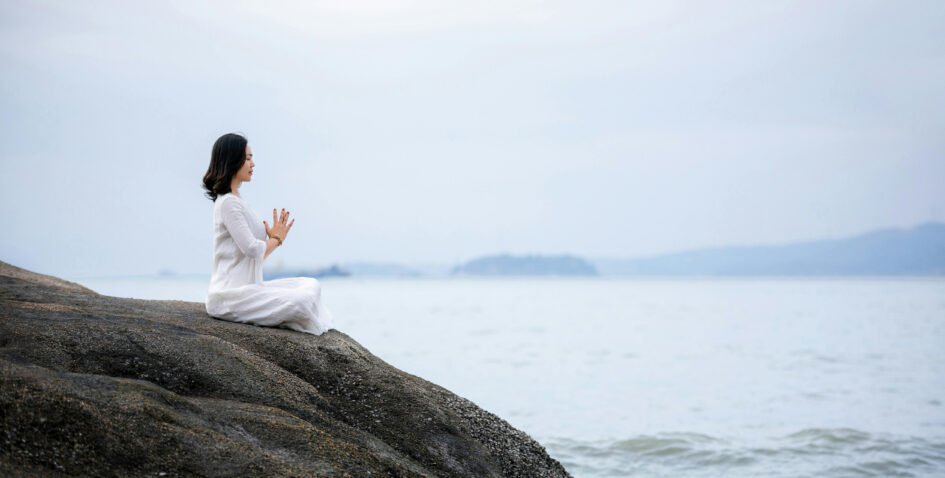Grounding, also known as earthing, is a therapeutic technique that involves making direct skin contact with the surface of the Earth. This can be achieved through barefoot walks on the grass or sand, touching trees, petting animals, swimming in natural bodies of water, or even sitting on natural materials like cotton or linen mats placed directly on the ground. You can also ground yourself by standing on a concrete floor that is in contact with the Earth. This simple practice connects us with the earth’s natural energy and has been found to reduce stress, improve sleep, decrease inflammation, and enhance overall well-being.
This week, I invite you to explore the benefits of grounding. Experience how direct contact with nature can ground your energy and help to transform your mental and physical health.
Instructions
- Choose your grounding spot:
- Identify a natural setting where you can safely engage directly with the Earth. Ideal locations include gardens, parks, or beaches where you can walk barefoot. If walking barefoot isn’t an option, find ways to make physical contact with the earth by touching plants, leaning against trees, or interacting with animals during your excursion.
- Prepare for grounding:
- Schedule at least 30 minutes of grounding this week; aiming for 60 minutes would provide optimal benefits. Break this time into manageable segments if needed, such as three 10-minute sessions or two 30-minute sessions, fitting them into your daily routine. Pack some hydrating drinks and perhaps a journal to record your thoughts and feelings, enhancing your grounding journey.
- Engage fully during grounding:
- While grounding, immerse yourself in the physical sensations of the earth beneath you. If you’re walking barefoot, pay attention to the feel of the ground under your feet – the cool grass, warm sand, or rough soil. If you’re touching natural elements with your hands, feel the textures and temperatures. Breathe deeply to intensify the soothing effects of your connection with nature, allowing the earth’s stability to anchor your presence in the moment.
- Reflect on your experience:
- After each grounding session, take a moment to reflect on the physical and emotional changes you might observe. Do you feel calmer? Is your mood more uplifted? Keeping a journal of these reflections can help you track the cumulative benefits of your grounding practices, providing insights into how this connection affects your well-being over time.
Additional grounding opportunities:
- While gardening: Take the opportunity to garden barefoot or with bare hands. Feel the soil, plants, and their textures, allowing a deeper sensory connection with the earth.
- During walks: Integrate barefoot moments into your walks. If conditions allow, remove your shoes to connect directly with the ground, even if just for a short part of your walk.
- Outdoor meals and breaks: Arrange to have meals or coffee breaks outside when possible. Sit directly on the ground, perhaps on a natural fiber mat, to enhance your connection with the earth.
- Playtime: Whether with children or pets, try to play outdoors and go barefoot. Engaging in playful activities like this can be an especially joyful way to connect with nature.
- Working on laptop outside: Set up a workspace outside where you can work on your laptop. This can help you enjoy fresh air and natural light while completing your tasks.
- Meditating on the ground: Find a tranquil spot outdoors for your meditation practice. Sitting directly on the earth can enhance your feelings of groundedness and peace, helping you to connect more deeply with the natural environment around you.
- Creative work outside: Take your creative projects outdoors. Whether it’s writing, drawing, or crafting, being outside can boost your creativity and mood.
- Grounding in different weather conditions and at various times: Experiment with grounding in diverse weather conditions – whether it’s under the sunny sky, during a gentle rain, or in the crisp chill of early morning or late evening. Try engaging in grounding activities at different times of the day, such as watching the sunrise to start your day with tranquility, or observing the sunset to unwind. You might also consider stargazing at night or seeking out the Aurora Borealis. These practices do more than connect you to the Earth; they sync you with the broader rhythms of nature and the solar cycle, deepening your grounding experience and enhancing your internal clock.
Resources for further exploration:
- The effects of grounding on health
- Grounding and mood
- Comprehensive review on grounding benefits
- Technology and lack of grounding
- Earthing videos
- Dr. Laura Koniver’s grounding tips
Photo from Pexels.com, Shu Lei: https://www.pexels.com/@shu-lei-2809836/





Leave a Reply